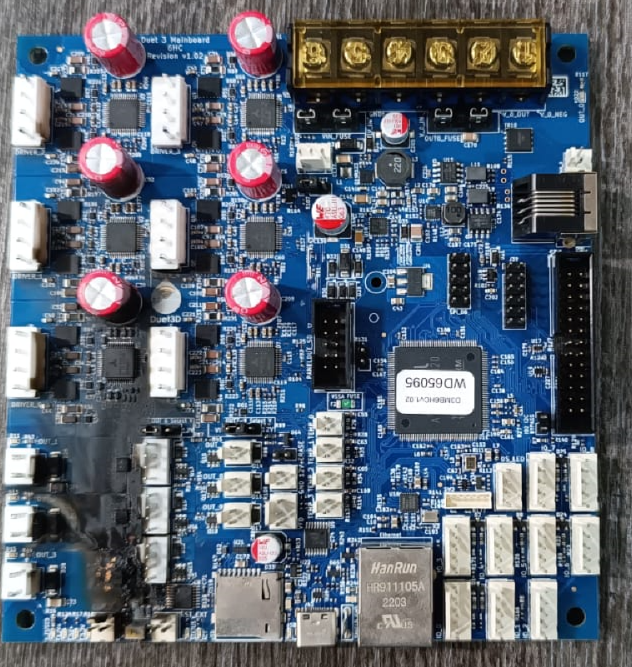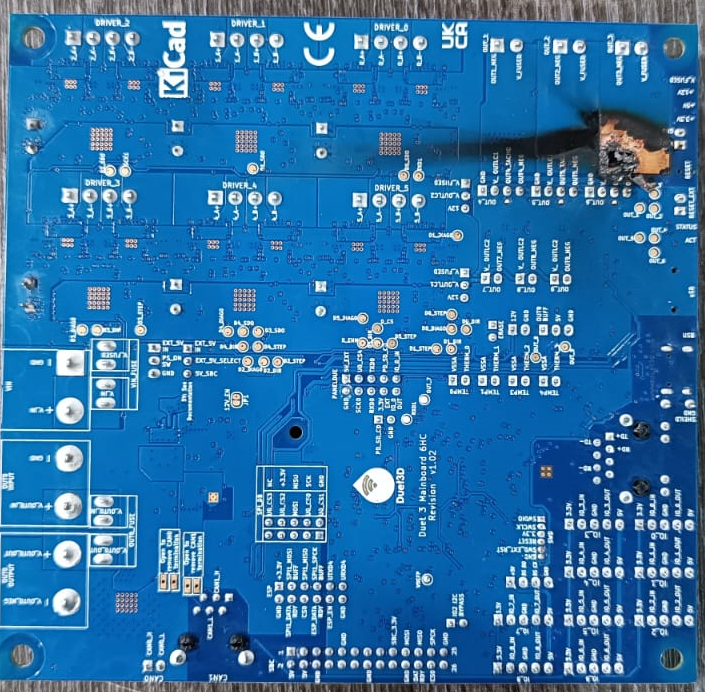Duet 6HC v1.02 burns by electric short circuit
-
our duet 6hc has burned after a shot circuit in OUT3. In previous versions the circuit had a 50A mosfet but in v1.02 the mosfet maximun current is 9.6A.
The mosfet has a cooper dispator and can enduring more current than 9.6A but in this case was not enough and the mosfet becomes burn before the 15A fuse works.
For me this is a desing fail, the circuit must to be protectec and designed againts any overload.
-
For me this is a desing fail
For me, it’s a read fail. From the specifications:
High current outputs: OUT0 up to 18A (see note above), OUT1/2/3 up to 6A each
the circuit must to be protectec and designed againts any overload.
You can’t protect a complex controller like the 6HC against all potential risks from all thinkable printer designs. If you integrate components of your choice into a machine, it’s your task as the builder of the machine to provide fuses and other means to protect the installed components against failures. That’s a question of proper system design.
-
| OUT1/2/3 up to 6A each
This is the recommended current, but in the data sheet the max mosfet current is 9.6A, other data, the previus version mosfet is 50A.
with 50A mosfet the 15A fuse will work and avoid overload.
May be it is necessary to read well specifications after new version but the components after fuse must to be dimensioned to enduring until fuse work.
OK, you can not protect the duet against any risk but The problem is that there is a fused to protect circuits under VFUSED, a good desing muts to keep this in account.
Of course after this incident we will put fuse in not protected lines.
-
@odisea2217, A fuse takes a certain time to react. Generally the MOSFET is much quicker to burn out. It is not uncommon to have the MOSFET die even though the fuse is still ok (ask me how I know this
 )
)
I do not know if a fast acting fuse will be fast enough but if you find out, I would be interested to hear about that. To my knowledge, the only way to protect the output MOSFETS is with operator brain power (which I admit has been an issue with me in the past) -
This is the recommended current, but in the data sheet the max mosfet current is 9.6A
No, this is the specification: OUT1-3 are defined to deliver up to 6A. If the MOSfet is capable of more than that, that's no invitation to explore the limits. You simply can't know which considerations (cooling, safety margins, availability, …) lead to the selection of a specific component.
Of course after this incident we will put fuse in not protected lines.
That's good practice.
-
@jens55 said in Duet 6HC v1.02 burns by electric short circuit:
I do not know if a fast acting fuse will be fast enough but if you find out, I would be interested to hear about that. To my knowledge, the only way to protect the output MOSFETS is with operator brain power (which I admit has been an issue with me in the past)
In my previous life, I worked for one of the biggest electronics companies in the world. The design group had done some research on this and had huge experience library. So: Both fuses and chips die from overcurrent by burning. Chip lines are literally microscopic and much better heat insulated (related to their size) than any fuse. On short circuit situation, the chip is always way faster. Fuses are good in preventing fires: something downstream heats up which generally means resistance is getting lower which means even more current etc. Equipment protection against short circuits is totally different subject.
-


-
What a mighty blow! Are you running the 6HC on a welding transformer?
-
My thoughts exactly. I can't recall ever seen a blown output with more than a tiny section of the MOSFET missing. Usually you have to search very carefully. I suspect that this was way more than just a shorted output.